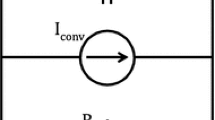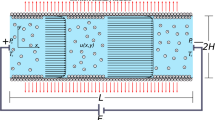Abstract
This article deals with the electroosmotic flow through nanochannel filled with electrolyte solution surrounded by an immiscible oil layer where the fluid is driven by either DC or AC electric field. The walls of the nanochannel are considered to bear a constant negative surface charge. Additional mobile ions with positive polarity are present in the surface oil layer. The electrostatic potential can be obtained from the nonlinear Poisson-Boltzmann equation. With the known electric potential, we calculate the axial velocity distribution from the unsteady Stokes equation. The effects of intrinsic parameters on the overall electrostatic behavior as well as velocity distribution are discussed in a great detail. We identify several interesting key features of the flow distributions under externally applied DC or AC electric field. For lower range of Debye-Huckel parameter, the overlap of adjacent electric double layers significantly affects the flow profile. In addition for externally applied sinusoidal AC electric field, a finite settling time is required to diffuse the momentum of the fluid from the adjacent region of the channel wall to the bulk fluid. As a result, a phase shift between the applied electric field and velocity field may occur. Under AC electric field, the oscillatory behavior of the axial velocity is further investigated.









Similar content being viewed by others
References
Hunter RJ (1981) Foundations of colloid science, 2nd edn. Oxford University, Press, New York
Whitesides GM, Stroock AD (2000) Flexible methods for microfluidics. Phys Today 54:42–48
Masliyah JH, Bhattacharjee S (2006) Electrokinetic and colloid transport phenomena. Wiley-Interscience
Patankar NA, Hu HH (1998) Numerical simulation of electroosmotic flow. Anal Chem 70:1870–1881
Ghosal S (2002) Lubrication theory for electroosmotic flow in a microfluidic channel of slowly varying cross-section and wall charge. J Fluid Mech 459:103–128
Bhattacharyya S, Zheng Z, Conlisk AT (2005) Electroosmotic flow in two-dimensional charged micro and nanochannels. J Fluid Mech 540:247–267
Park HM, Lee JS, Kim TW (2007) Comparison of the Nernst-Planck model and the Poisson-Boltzmann model for electroosmotic flows in microchannels. J Colloid Interface Sci 315:731– 739
Talapatra S, Chakraborty S (2008) Double layer overlap in AC electroosmosis. Eur J Mech B Fluid 27:297–308
Yang C, Ooi KT (2005) Two-fluid electroosmotic flow in microchannels. J Colloid Interface Sci 284:306–314
Gao Y, Wong TN, Chai JC, Yang C, Ooi KT (2005) Numerical simulation of two-fluid electroosmotic flow in microchannels. Int J Heat Mass Transfer 48:5103–5111
Wang C, Gao Y, Nguyen NT, Wong TN, Yang C, Oii KT (2005) Interface control of pressure-driven two-fluid flow in microchannels using electroosmosis. J Micromech Microeng 15:2289–2297
Salim A, Fourar M, Pironon J, Sausse J (2008) Oil-water two-phase flow in microchannels: flow patterns and pressure drop measurements. The Canadian J. Chem. Eng. 86:978–988
Movahed S, Khani S, Wen JZ, Li D (2012) Electroosmotic flow in a water column surrounded by an immiscible liquid. J Colloid Interface Sci 372:207–221
Brask A, Goranoic G, Bruus H (2003) Electroosmotic pumping of nonconducting liquids by viscous drag from a secondary conducting liquid. Proc. NanoTech San Francisco, CA 1:190–193
Watanabe M, Shirai H, Hirai T (2003) Liquid-liquid two layer electrohydrodynamic flow system. Sensors Actuat B 94:267–270
Oddy MH, Santiago JG, Mikkelsen JC (2001) Electrokinetic instability micromixing. Anal Chem 73:5822–5832
Wong PK, Chen C-Y, Wang T-H, Ho C-M (2004) Electrokinetic bioprocessor for concentrating cells and molecules. Anal Chem 76:6908–6914
Hughes MP (2002) Strategies for dielectrophoretic separation in laboratory-on-a-chip systems. Electrophoresis 23:2569–2582
Barragan VM, Bauza CR (2000) Electroosmosis through a cation-exchange membrane: effect of an AC perturbation on the electroosmotic flow. J Colloid Interface Sci 230:359–366
Dutta P, Beskok A (2001) Analytical solution of combined electroosmotic/pressure driven flows in two-dimensional straight channels: Finite debye layer effects. Anal Chem 73:1979–1986
Luo WJ (2004) Transient electroosmotic flow induced by DC or AC electric fields in a curved microtube. J Colloid Interface Sci 278:497–507
Su J, Jian YJ, Chang L, Liu QS (2013) Transient electro-osmotic and pressure driven flows of two layer fluids through a slit microchannel. Acta Mech Sinica 29:534–542
Gao Y, Wong NW, Yang C, Oii KT (2005) Transient two-liquid electroosmotic flow with electric charges at the interface. Colloids Surf A Physicochem Eng Asp 266:117–128
Ohshima H, Nomura K, Kamaya H, Ueda I (1985) Liquid membrane: equilibrium potential distribution across lipid monolayer-coated oil/water interface. J Colloid Interface Sci 106:470–478
Gopmandal PP, Ohshima H (2017) Modulation of electroosmotic flow through electrolyte column surrounded by a dielectric oil layer. Colloid Polym Sci 295:1141–1151
Stein D, Kruithof M, Dekker C (2004) Surface-charge-governed ion transport in nanofluidic channels. Phys Rev Lett 93:035901
Prakash S, Zambrano HA, Rangharajan KK, Rosenthal-Kim E, Vasquez N, Conlisk A (2016) Electrokinetic transport of monovalent and divalent cations in silica nanochannels. Microfluid Nanofluid 20:1–8
Yang M, Yang X, Wang K, Wang Q, Fan X, Liu W, Lui X, Liu J, Huang J (2015) Tuning transport selectivity of ionic species by phosphoric acid gradient in positively charged nanochannel membranes. Anal Chem 87:1544–1551
Leunissen ME, Zwanikken J, Roij R, Chaikin PM, van Blaaderen A (2007) Ion partitioning at the oil–water interface as a source of tunable electrostatic effects in emulsions with colloids. Phys Chem Chem Phys 9:6405–6414
Yethiraj A, van Blaaderen A (2003) A colloidal model system with an interaction tunable from hard sphere to soft and dipolar. Nature 421:513–517
Hsu MF, Dufresne ER, Weitz DA (2005) Charge stabilization in nonpolar solvents. Langmuir 21:4881–4887
Ohshima H (2008) Donnan potential and surface potential of a spherical soft particle in an electrolyte solution. J Colloid Interface Sci 323:92–97
Haywood DG, Harms ZD, Jacobson SC (2014) Electroosmotic flow in nanofluidic channels. Anal Chem 86:11174–11180
Sugioka H (2014) Dc step response of induced-charge electro-osmosis between parallel electrodes at large voltages. Phys Rev E 90:013007
Chakraborty S, Ray S (2008) Mass flow-rate control through time periodic electro-osmotic flows in circular microchannels. Phys Fluids 20:083602
Funding
The authors (PPG & SS) acknowledges the financial support received from the Science and Engineering Research Board (SERB), Department of Science & Technology, Government of India, through the project grant (File no. YSS/2015/000468).
Author information
Authors and Affiliations
Corresponding author
Ethics declarations
Conflict of interests
The authors declare that they have no conflict of interest.
Rights and permissions
About this article
Cite this article
Saha, S., Gopmandal, P.P. & Ohshima, H. Steady/unsteady electroosmotic flow through nanochannel filled with electrolyte solution surrounded by an immiscible liquid. Colloid Polym Sci 295, 2287–2297 (2017). https://doi.org/10.1007/s00396-017-4204-8
Received:
Revised:
Accepted:
Published:
Issue Date:
DOI: https://doi.org/10.1007/s00396-017-4204-8




